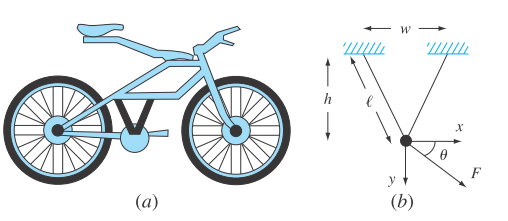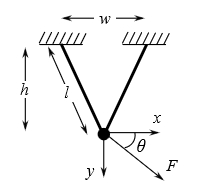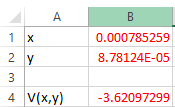
Recent interest in competitive and recreational cycling has meant that engineers have directed their skills toward the designand testing of mountain bikes (Fig. P16.33a). Suppose that you are given the task of predicting the horizontal and vertical displacement of a bike bracketing system in response to a force. Assume the forces you must analyze can be simplified as depicted in Fig. P16.33b. You are interested in testing the response of the truss to a force exerted in any number of directions designated by the angle

FIGURE P16.33
(a) A mountain bike along with (b) a free-body diagram for a part of the frame.
To calculate: The minimum potential energy with displacement

Answer to Problem 33P
Solution:
The minimum potential energy with displacement
Explanation of Solution
Given Information:
The parameters are given as Young’s modulus E is

Calculation:
Consider the free body diagram,

The potential energy at a position where horizontal displacement is x and vertical displacement is y, first consider the angular deflection of the bracket and then use the concept of energy stored in a bracket system due to deflection.
For
Substitute the values
To minimize this, the excel solver can be used to solve for the displacement.
The excel solver steps are,
Step 1. Initiate quantity

Step 2. Apply the formula in

Step 3. Go to DATA and then click on Solver. This dialog box will appear.

Step 4. Select the set objective, min, changing variable then this dialog box appears.

Step 5. Click on Solve and then OK.

Hence, the minimum potential energy with displacement
Put
The potential energy can be found out with upper procedure as
The potential energy will be
Thus from the above analysis, it can be concluded that x deflection is maximum when load is pointed in the x direction and y deflection is maximum when load is pointed in the y direction.
However x deflection is more than y direction as potential energy is higher at lower angle.
This can also be concluded that if w values increases then deflection would be more uniform throughout.
Want to see more full solutions like this?
Chapter 16 Solutions
EBK NUMERICAL METHODS FOR ENGINEERS
- rounded to two decimal places at each calculationarrow_forwardUse Variation of Parameters to solvearrow_forwardMoment of a Force 2.14 Ma= Does Box Tip Over?=- 2.15 (change beam weight to 900 N)) X= 2.17 P= Varignon's Theorem 2.19 (change story height to 5m) Ma= 2.21 MA=. MB=_ 2.23 (change maximum tension to 2500 lbs) W= Couple and Moment of a Couple 2.24 MA=. MB=_ 2.26 (change force to 110 KN) F= M= Answer all parts, please.arrow_forward
- read chapter 10 welding principles and applications, short-circuiting, transfer, GMAW – S. Explain why the power supply is critical in the short-circuiting transfer process. Discuss what happens if there’s too much or two little inductance.arrow_forwarda. Find the general flow pattern of the network shown in the figure. b. Assuming that the flow must be in the directions indicated, find the minimum flows in the branches denoted by X2, X3, X4, and x5 a. Choose the correct answer below and fill in the answer boxes to complete your choice. OA. x₁ = X2 is free X3 is free B. X₁ is free x2= ×4 is free X5 is free X6 = X3= X4 X5 X6 = 11 = ○ C. D. X2 is free X3= X4 is free X5 is free x2 = 0 X3 is free ×4 = X6 is free gave 20 30 12 C 804 60-> B <<90 314 X4D -80 E T 20 40 xarrow_forwardConsider an economy with three sectors, Chemicals & Metals, Fuels & Power, and Machinery. Chemicals sells 30% of its output to Fuels and 60% to Machinery and retains the rest. Fuels sells 70% of its output to Chemicals and 20% to Machinery and retains the rest. Machinery sells 40% of its output to Chemicals and 30% to Fuels and retains the rest. Complete parts (a) through (c) below a. Construct the exchange table for this economy. Distribution of Output from: Chemicals Fuels Machinery (Type integers or decimals.) Purchased by: Chemicals Fuels Machineryarrow_forward
- Algebra & Trigonometry with Analytic GeometryAlgebraISBN:9781133382119Author:SwokowskiPublisher:Cengage


